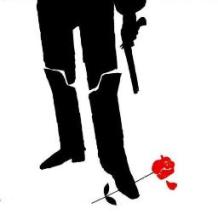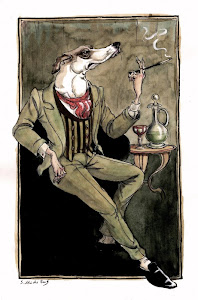 One of the drawbacks of living in Southern California is the dearth of occasions on which I can deploy my heavy outerwear. I am referring to trench coats and overcoats. When friends back East complain about the rain and the snow, I mourn the loss of opportunities to take my coats out for a spin. In the past, my preferences on the whole have been equally divided between the two, depending on purpose and season. The relatively light-weight, military style of the trench coat appeals to me. The trench is perfect for long train commutes into the city or for taking a Saturday stroll along Park Avenue in early November. It is also useful if you are stalking up-to-no-gooders through the grimy streets of the 15th arrondissement of Paris. Below, I have added a brief history of the Trench Coat for your perusal:
One of the drawbacks of living in Southern California is the dearth of occasions on which I can deploy my heavy outerwear. I am referring to trench coats and overcoats. When friends back East complain about the rain and the snow, I mourn the loss of opportunities to take my coats out for a spin. In the past, my preferences on the whole have been equally divided between the two, depending on purpose and season. The relatively light-weight, military style of the trench coat appeals to me. The trench is perfect for long train commutes into the city or for taking a Saturday stroll along Park Avenue in early November. It is also useful if you are stalking up-to-no-gooders through the grimy streets of the 15th arrondissement of Paris. Below, I have added a brief history of the Trench Coat for your perusal:The Battle of the Classic Outwear
by Tom Stubbs
Finch's Quarterly Review
Autumn 2009
A brief history of the Trench Coat. When the Crimean war broke out in 1854 new fangled cannon technology made charging about on horses shamefully ridiculous. Nouveau war mainly involved scrabbling about in muddy trenches. This required innovative lightweight kit and clobber, with characteristics such as freedom of movement, protection from the elements combined with elegance worthy of officer types.
Outfitters began devising suitable garb. John Emery founded Aquascutum taking its name from the Latin words for water and shield, and had begun devising shower proof wool coats. Meanwhile in Basingstoke, Thomas Burberry was putting his rainproof ‘Gabardine’ fabric to good use too, just in time for the Boer war to begin, partly inspired by the dynamic belted outwear worn by farm labourers in his area. Now components were combined to produce a versatile and multi functional technical garment.

By the time the Great War began the Trench coat had been contrived. A distinctive Raglan sleeve was used, already invented for Lord Raglan minus his arm. Additional features included a top stitched belt with D rings to hang military paraphernalia from, a storm flap fastening against wind along with a hook and eye collar fastening device, epaulettes for bag straps, and a cape styled shoulder yolk all cleverly coalesce to deliver a uniquely recognisable item of outwear. The oblong leather buckles on the belt and sleeve fastenings and two rows of horn buttons are also very much part of trench DNA.
The officers needed to look dashing as they marshalled the slaughter, so key trench coat protagonists fashion an elongated and striking looking affair. Charged with style, the cache of brave modern soldiering and excellent rain repellence, the trench became a peacetime hit, adopted by icons of screen and notables of society. The abundance of design details and form to play with has given modern designers endless scope to tweak. From very classic to extraordinary hybrids in unexpected fabrics, the trench is as rampantly important this season as any. My favourites are the more pert versions that have a set in sleeve, flaunting Raglan tradition. Stake your trench claim in our battle of the outwear.
© FQR
http://www.finchsquarterly.com/fqr-style/stubbs-style/the-battle-of-the-classic-outwear/






















3 comments:
Showing Richard Meinertzhagen in a trencoat was the perfect choice. The Colonel, stylish, brutal and fraudulent, was one of my boyhood heroes.
It rained heavily in New York City on Wednesday. I dug my old Brooks Brothers trench (purchased in 1999) out of my side closet. A number of women (perhaps 100) glanced at me admiringly - I don't know if it was the coat or me - I suspect the coat.
The torrential downpours of Chicago don't compare to the perma-drizzle that you encounter in London. There's no point carrying a trenchcoat for a downpour so profuse that it would soak you to the skin anyway.
Post a Comment